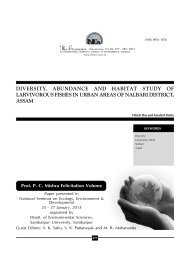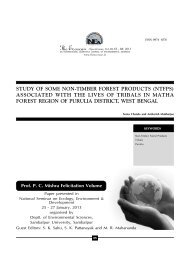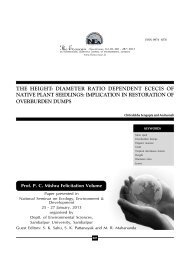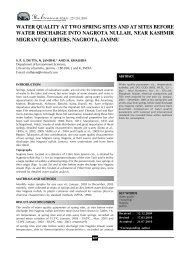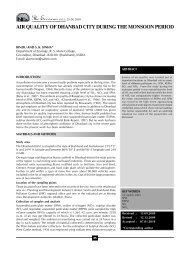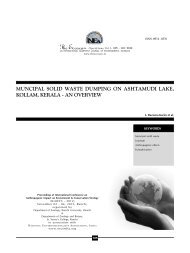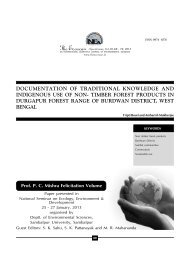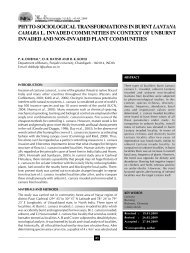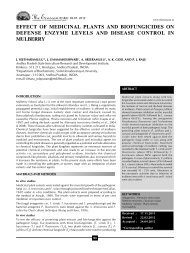full paper.pdf - An International Quarterly Journal of Environmental ...
full paper.pdf - An International Quarterly Journal of Environmental ...
full paper.pdf - An International Quarterly Journal of Environmental ...
You also want an ePaper? Increase the reach of your titles
YUMPU automatically turns print PDFs into web optimized ePapers that Google loves.
NSave Nature to Survive<br />
QUARTERLY<br />
4(4) : 263-271, 2010<br />
www.theecoscan.in<br />
SEASONAL VARIATION IN PHYSICO-CHEMICAL AND MICRO-<br />
BIOLOGICAL PARAMETERS OF MAHANADI RIVER WATER IN AND<br />
AROUND HIRAKUD, ORISSA (INDIA)<br />
P. K. KAR*, K. R. PANI, S. K. PATTANAYAK 1 AND S. K. SAHU 1<br />
Department <strong>of</strong> Chemistry, V. S. S. University <strong>of</strong> Technology, Burla - 768 018, INDIA<br />
1<br />
Department <strong>of</strong> <strong>Environmental</strong> Science, Sambalpur University, Burla - 768 019, INDIA<br />
E-mail: pravinkar@yahoo.com<br />
ABSTRACT<br />
INTRODUCTION<br />
Hirakud town is an industrial hub in the district <strong>of</strong> Sambalpur, located in the<br />
western part <strong>of</strong> Orissa and south-eastern part <strong>of</strong> India. It is situated on the left<br />
bank <strong>of</strong> river Mahanadi in the down stream <strong>of</strong> Hirakud Dam reservoir which is<br />
constructed across the river in 1950’s. The flow <strong>of</strong> water in the river Mahanadi is<br />
controlled by the Hirakud dam. The area lies at 21º31’59’’ NL and 83º54’46’’ EL<br />
and is at about 162 meter above mean sea level (MSL). Industries like aluminium,<br />
power, rolling and cable are situated in Hirakud. Besides many residential colonies,<br />
a large number <strong>of</strong> villages are also present in and around this area. There are also<br />
many industries like Steel, aluminum, power, sponge iron etc. in the upstream <strong>of</strong><br />
Hirakud Dam alongside the reservoir. The drainage network <strong>of</strong> the area is<br />
controlled by river Mahanadi. A rivulet flows through the central part <strong>of</strong> the town<br />
before meeting the river Mahanadi on its left bank. It carries almost all the industrial<br />
effluents and also a sizeable load <strong>of</strong> domestic effluent from industrial townships<br />
<strong>of</strong> Hirakud.<br />
Lakes, rivers and streams are the sources <strong>of</strong> drinking water, irrigation, fishery and<br />
energy production (Iscen et al., 2008). Almost all the fresh water bodies are being<br />
polluted by expanding human population and in consequence, industrialization,<br />
intensive agricultural practices and discharges <strong>of</strong> massive amount <strong>of</strong> wastewater<br />
etc. which result in deterioration <strong>of</strong> water quality (Sinha, 1986). The main pollutants<br />
that pose to natural water quality problems are organic wastes, bacteria, nutrients<br />
and other chemical substances. These parameters could be affected by external<br />
and internal factors. There is an intricate relationship between the external and<br />
internal factors in aquatic environments. Meteorological events and pollution<br />
are a few <strong>of</strong> the external factors which affect physico-chemical parameters such<br />
as temperature, pH and dissolved oxygen (DO) <strong>of</strong> the water. These parameters<br />
have major influences on biochemical reactions that occur within the water.<br />
Sudden changes <strong>of</strong> these parameters may be indicative <strong>of</strong> changing conditions<br />
in the water. Internal factors, on the other hand, include events, which occur<br />
between and within bacterial and plankton populations in the water body<br />
(Bezuidenhout et al., 2002).<br />
The physico-chemical and microbiological parameters <strong>of</strong> different fresh water<br />
systems (river, stream, ocean etc.) have been studied by various researchers<br />
(Panda et al., 1991; Sahu et al., 1991; Singh et al., 2004; Ghose et al.,<br />
2009).However, no comprehensive work has been done till yet to explore the<br />
seasonal variation in physico-chemical and microbiological parameters on the<br />
water quality <strong>of</strong> river Mahanadi at Hirakud. Keeping this in view, a work was<br />
undertaken during the period 2007-2009 to measure some physico-chemical<br />
and microbial (total and faecal coliform counts) parameters <strong>of</strong> Mahanadi river<br />
water in and around Hirakud in different seasons.<br />
The physical, chemical and microbiological<br />
characteristics <strong>of</strong> Mahanadi river water in and<br />
around Hirakud, Orissa have been studied<br />
from October, 2007 to September, 2009 in<br />
four different seasons (monsoon, postmonsoon,<br />
winter and premonsoon) to evaluate the<br />
suitability <strong>of</strong> water for various uses. The water<br />
samples were collected from four different<br />
points - the Hirakud dam reservoir, upstream,<br />
middle stream and downstream <strong>of</strong> the river<br />
channel. The samples were analysed for 18<br />
physico-chemical parameters viz. water<br />
temperature, turbidity, pH, electrical<br />
conductivity, total dissolved solids, DO, total<br />
hardness, total alkalinity, chemical oxygen<br />
demand, biological oxygen demand, fluoride,<br />
chloride, cyanide, sulphate, arsenic, mercury,<br />
faecal and total coliform. Pearson’s correlation<br />
coefficients were calculated to show<br />
correlations between various parameters using<br />
MINITAB s<strong>of</strong>tware v.15.10. The Water quality<br />
index was also calculated using NSF water<br />
quality calculator. It was observed that the<br />
Mahanadi river water in this region is <strong>of</strong><br />
category D, i.e. bad, and therefore it requires<br />
urgent attention.<br />
KEY WORDS<br />
Mahanadi river water, Hirakud township,<br />
Water Physico-chemical parameters, Water<br />
Biological parameters and NSF water quality<br />
index<br />
Received : 17.09.2010<br />
Revised : 09.10.2010<br />
Accepted : 11.11.2010<br />
*Corresponding author<br />
263
P. K. KAR et al.,<br />
MATERIALS AND METHODS<br />
Water quality analysis<br />
Water samples were collected from four study sites (reservoir<br />
stretch, upstream stretch, midstream stretch and down stream<br />
stretch) (Fig. 1) at monthly intervals between October 2007<br />
and September 2009, covering four seasons i.e.<br />
monsoon(June-September), post monsoon(October-<br />
November), winter (December-February) and pre monsoon<br />
(March-May). The physico-chemical parameters like<br />
Temperature, Turbidity, Dissolved Oxygen, pH, Conductivity,<br />
Total Hardness, Total Alkalinity, Total Dissolved solids,<br />
Chemical Oxygen Demand, Biological Oxygen Demand,<br />
Fluoride, Chloride, Cyanide, Sulphate, Arsenic and Mercury;<br />
and biological parameters like Fecal and Total coliform bacteria<br />
were measured.<br />
Standard methods (APHA, 1989; BIS, 1984) were used for<br />
collection, preservation and estimation <strong>of</strong> water samples.<br />
Samples were collected in 2 liters sterile bottles in triplicate.<br />
Except temperature and pH, all other parameters were<br />
determined at VSS University <strong>of</strong> Technology laboratory<br />
(formerly UCE, Burla). Water temperature and pH were<br />
estimated on the spot with a mercury thermometer and<br />
portable Taiwan made pH meter respectively. For dissolved<br />
oxygen (DO), water was collected in BOD bottles and the<br />
oxygen was fixed on the spot following Kilian (1997).The DO<br />
and microbiological analysis were done within 3 hour after<br />
sampling <strong>of</strong> water and BOD analysis was done after incubating<br />
the water samples for 3 days at 27ºC.<br />
Statistical Procedures<br />
Physico-chemical and microbiological parameters <strong>of</strong> the water<br />
samples were presented in terms <strong>of</strong> Mean ± 2SD. Pearson’s<br />
correlation coefficient (r) was determined using MINITAB<br />
Statistical S<strong>of</strong>tware 15.10 to show relationship between all the<br />
parameters. The water quality index was calculated using the<br />
NSF water quality index calculator.<br />
RESULTS AND DISCUSSION<br />
Seasonal variations in physico-chemical and microbiological<br />
parameters from four sampling sites <strong>of</strong> the river Mahanadi are<br />
shown in Figs. 2 to 19. The average value <strong>of</strong> all parameters<br />
(Mean ± 2SD) are given in Table 1 and correlation coefficients<br />
between various parameters are given in Table 2. The obtained<br />
values <strong>of</strong> different parameters were also compared with the<br />
prescribed limits given in BIS Water Quality Guidelines (Table<br />
3) and water quality was categorized according to NSF WQI,<br />
i.e. excellent quality waters (Category A), good quality waters<br />
(Category B), medium quality waters (Category C), bad waters<br />
(Category D) and very bad waters (Category D) ( Table 4).<br />
Temperature<br />
Temperature is an important physical parameter <strong>of</strong> water<br />
quality which has a direct effect on aquatic life as because it<br />
reduces the dissolved oxygen (DO) concentration in the water<br />
making oxygen less available for respiration. Temperature also<br />
affects chemical reactions and reaction rates within the water,<br />
thereby influencing its suitability for irrigation (Metcalf and<br />
Eddy, 2003). In the present investigation, the temperature <strong>of</strong><br />
Mahanadi river water at reservoir, upstream, middle stream<br />
and downstream sites varied between 25.8ºC (Winter,<br />
Reservoir) and 32.4ºC (Pre monsoon, Downstream) (Fig. 2)<br />
with mean temperature <strong>of</strong> 28.2 ± 4.37, 28.5 ± 4.4, 28.7 ±<br />
3.68, 29.4 ± 4.11 respectively (Table 1). Temperature <strong>of</strong> water<br />
was maximal at downstream indicating mixing <strong>of</strong> effluents<br />
with it (Fig. 2). Temperature showed significant positive<br />
correlation(r≥0.803, p< 0.05) with pH, BOD, TC indicating<br />
their rise with temperature (Table 2).<br />
Turbidity<br />
In most <strong>of</strong> the waters turbidity is due to colloidal and extremely<br />
fine dispersions. Suspended matter such as clay, slit, finely<br />
divided organic and inorganic matter, plankton and other<br />
microscopic organisms also contribute to Turbidity<br />
(Manivaskam, 1986). In the present study, the turbidity values<br />
Table 1: Values <strong>of</strong> physicochemical and microbiological parameters (Mean ± 2SD) <strong>of</strong> Mahanadi river water<br />
Parameters<br />
Sampling Sites<br />
Reservoir Upstream Middle stream Downstream Average<br />
Temperature(ºC) 28.2 ± 4.37 28.5 ± 4.40 28.7 ± 3.68 29.4 ± 4.11 28.7 ± 1.01<br />
Turbidity (NTU) 88.5 ± 6.32 85.0 ± 5.21 87.9 ± 5.80 96.1 ± 9.90 89.4 ± 9.43<br />
pH 7.51 ± 0.71 7.47 ± 0.50 7.44 ± 0.54 7.49 ± 1.00 7.48 ± 0.06<br />
Conductivity (mS/cm) 0.87 ± 0.13 0.75 ± 0.07 0.78 ± 0.08 0.85 ± 0.15 0.81 ± 0.11<br />
DO (mg/L) 7.10 ± 0.55 7.31 ± 0.46 7.37 ± 0.34 7.0 ± 0.72 7.19 ± 0.35<br />
Total Hardness (mg/L) 129.8 ± 45.87 124.6 ± 37.32 115.9 ± 36.60 143.4 ± 32.68 127.7 ± 23.89<br />
Total Alkalinity (mg/L) 31.75 ± 17.75 29.16 ± 17.00 27.18 ± 16.50 34.44 ± 21.73 30.63 ± 6.31<br />
TDS (mg/L) 273.6 ± 30.64 263.5 ± 36.06 251.5 ± 36.86 285.8 ± 34.91 268.6 ± 29.22<br />
TSS (mg/L) 41.3 ± 12.12 32.9 ± 11.10 31.6 ± 12.06 45.7 ± 14.90 37.9 ± 13.57<br />
TS (mg/L) 314.9 ± 42.21 296.4 ± 47.04 283.1 ± 48.63 331.6 ± 49.78 306.5 ± 42.42<br />
COD (mg/L) 49.0 ± 19.84 43.5 ± 17.02 40.8 ± 15.45 53.2 ± 18.85 46.7 ± 11.11<br />
BOD (mg/L) 33.8 ± 11.44 29.9 ± 13.91 28.1 ± 16.36 37.5 ± 13.53 32.3 ± 8.41<br />
Fluoride (mg/L) 0.78 ± 0.27 0.71 ± 0.27 0.59 ± 0.23 0.75 ± 0.23 0.71 ± 0.17<br />
Cyanide(mg/L) 0.072 ± 0.017 0.062 ± 0.019 0.057 ± 0.015 0.073 ± 0.012 0.066 ± 0.015<br />
Chloride (mg/L) 67.79 ± 40.83 56.89 ± 36.22 49.69 ± 39.56 64.30 ± 38.09 59.67 ± 16.11<br />
Sulphate (mg/L) 74.75 ± 15.05 71.29 ± 17.90 67.83 ± 21.84 73.09 ± 14.81 71.74 ± 5.94<br />
Arsenic (mg/L) 0.0036 ± 0.0008 0.0032 ± 0.0008 0.0029 ± 0.0008 0.0034 ± 0.0007 0.0032 ± 0.0006<br />
Mercury (mg/L) 0.0015 ± 0.0006 0.0013 ± 0.0006 0.0011 ± 0.0004 0.0014 ± 0.0004 0.0013 ± 0.0003<br />
FC (MPN/100mL) 193 ± 57 206 ± 69 222 ± 73 240 ± 73 215 ± 40<br />
TC (MPN/100mL) 482 ± 62 474 ± 60 467 ± 54 492 ± 68 479 ± 21<br />
264
SEASONAL VARIATION IN MAHANADI RIVER WATER<br />
Table 2: Correlation-coefficient matrix showing relationship between different physico-chemical and biological parameters <strong>of</strong> Mahanadi river water in and around Hirakud<br />
Temp. Turb. pH EC DO TH TA TDS COD BOD Fluoride Cyanide Chloride Sulphate Arsenic Mercury FC<br />
Temp. 1.000<br />
Turbidity 0.160 1.000<br />
pH 0.838 -0.213 1.000<br />
Conductivity(EC) 0.050 0.746 -0.182 1.000<br />
DO -0.791 0.347 -0.733 -0.409 1.000<br />
Total Hardness (TH) 0.510 0.248 0.600 0.089 -0.490 1.000<br />
Total Alkalinity(TA) 0.679 -0.059 0.859 -0.163 -0.587 0.877 1.000<br />
TDS 0.088 0.822 -0.240 0.837 -0.405 0.050 -0.199 1.000<br />
COD 0.758 0.597 0.521 0.610 -0.816 0.577 0.512 0.632 1.000<br />
BOD 0.803 0.545 0.600 0.497 -0.843 0.606 0.591 0.556 0.946 1.000<br />
Fluoride 0.330 0.564 0.049 0.773 -0.552 0.078 -0.031 0.874 0.770 0.704 1.000<br />
Cyanide 0.289 0.726 0.055 0.846 -0.616 0.223 0.066 0.904 0.786 0.741 0.926 1.000<br />
Chloride 0.054 0.637 -0.286 0.836 -0.303 -0.231 -0.391 0.905 0.539 0.457 0.908 0.846 1.000<br />
Sulphate -0.026 0.597 -0.311 0.739 -0.09 -0.050 -0.260 0.823 0.510 0.405 0.798 0.733 0.858 1.000<br />
Arsenic 0.159 0.603 -0.095 0.863 -0.443 0.055 -0.101 0.897 0.693 0.611 0.957 0.929 0.921 0.864 1.000<br />
Mercury 0.030 0.642 -0.234 0.852 -0.325 -0.069 -0.252 0.916 0.601 0.508 0.927 0.903 0.948 0.882 0.955 1.000<br />
FC 0.806 0.539 0.490 0.245 -0.551 0.508 0.480 0.345 0.788 0.798 0.406 0.403 0.255 0.340 0.287 0.246 1.000<br />
TC 0.906 0.271 0.816 0.243 -0.807 0.743 0.801 0.238 0.884 0.909 0.465 0.467 0.139 0.183 0.350 0.201 0.801<br />
Figure1: Location <strong>of</strong> sampling sites in the study area <strong>of</strong> Mahanadi in<br />
and around Hirakud<br />
Temperature<br />
35.0<br />
33.0<br />
31.0<br />
29.0<br />
27.0<br />
25.0<br />
23.0<br />
21.0<br />
19.0<br />
17.0<br />
15.0<br />
Reservoir Upstream Middle Stream Down Stream<br />
Monsoon Post Monsoon Winter Pre Monsoon<br />
Figure 2: Seasonal variation <strong>of</strong> temperature in Mahanadi river water<br />
in and around Hirakud<br />
Turbidity<br />
120.00<br />
100.00<br />
80.00<br />
60.00<br />
40.00<br />
20.00<br />
0.00<br />
Reservoir Upstream Middle Stream Down Stream<br />
Monsoon Post Monsoon Winter Pre Monsoon<br />
Figure 3: Seasonal variation <strong>of</strong> turbidity in Mahanadi river water in<br />
and around Hirakud<br />
<strong>of</strong> water samples <strong>of</strong> Mahanadi river in four sites at Hirakud<br />
varied from 81.92 (Winter, upstream) to 102.73 (Monsoon,<br />
Downstream) (Fig. 3). The mean turbidity value was 88.5 ±<br />
6.32, 85.0 ± 5.21, 87.9 ± 5.80, 96.1 ± 9.90 in reservoir,<br />
upstream, middle stream and downstream respectively (Table<br />
265
P. K. KAR et al.,<br />
pH<br />
8.40<br />
8.20<br />
8.00<br />
7.80<br />
7.60<br />
7.40<br />
7.20<br />
7.00<br />
6.80<br />
6.60<br />
6.40<br />
Reservoir Upstream Middle Stream Down Stream<br />
Monsoon Post Monsoon Winter Pre Monsoon<br />
Figure 4: Seasonal variation <strong>of</strong> pH in Mahanadi river water in and<br />
around Hirakud<br />
Total Hardness<br />
180.00<br />
140.00<br />
100.00<br />
60.00<br />
Reservoir Upstream Middle Stream Down Stream<br />
Monsoon Post Monsoon Winter Pre Monsoon<br />
Figure 8: Seasonal variation <strong>of</strong> total hardness in Mahanadi river<br />
water in and around Hirakud<br />
Conductivity<br />
1.00<br />
0.95<br />
0.90<br />
0.85<br />
0.80<br />
0.75<br />
0.70<br />
0.65<br />
0.60<br />
0.55<br />
0.50<br />
Reservoir Upstream Middle Stream Down Stream<br />
Monsoon Post Monsoon Winter Pre Monsoon<br />
Figure 5: Seasonal variation <strong>of</strong> conductivity in Mahanadi river water<br />
in and around Hirakud<br />
350.00<br />
300.00<br />
Reservoir Upstream Middle Stream Down Stream<br />
Total Alkalinity<br />
60.00<br />
50.00<br />
40.00<br />
30.00<br />
20.00<br />
10.00<br />
0.00<br />
Reservoir Upstream Middle Stream Down Stream<br />
Monsoon Post Monsoon Winter Pre Monsoon<br />
Figure 9: Seasonal variation <strong>of</strong> total alkalinity in Mahanadi river<br />
water in and around Hirakud<br />
70.00<br />
60.00<br />
50.00<br />
Reservoir Upstream Middle Stream Down Stream<br />
TDS<br />
250.00<br />
200.00<br />
150.00<br />
COD<br />
40.00<br />
30.00<br />
20.00<br />
10.00<br />
100.00<br />
Monsoon Post Monsoon Winter Pre Monsoon<br />
Figure 6: Seasonal variation <strong>of</strong> TDS in Mahanadi river water in and<br />
around Hirakud<br />
8.00<br />
7.50<br />
Reservoir Upstream Middle Stream Down Stream<br />
0.00<br />
Monsoon Post Monsoon Winter Pre Monsoon<br />
Figure 10: Seasonal variation <strong>of</strong> COD in Mahanadi river water in and<br />
around Hirakud<br />
50.00<br />
40.00<br />
Reservoir Upstream Middle Stream Down Stream<br />
DO<br />
7.00<br />
6.50<br />
BOD<br />
30.00<br />
6.00<br />
20.00<br />
5.50<br />
5.00<br />
Monsoon Post Monsoon Winter Pre Monsoon<br />
Figure 7: Seasonal variation <strong>of</strong> DO in Mahanadi river water in and<br />
around Hirakud<br />
1). The maximum permissible value for turbidity as per BIS<br />
with respect to the drinking water is 10 NTU. The turbidity <strong>of</strong><br />
surface water at all sampling points was above the permissible<br />
limit (Table 1). The turbidity at all the sampling points was<br />
higher in monsoon as compared to other seasons which can<br />
be attributed to flow <strong>of</strong> muddy water. Further, the turbidity<br />
values <strong>of</strong> downstream were found to be more than other points<br />
indicating mixing <strong>of</strong> both industrial and domestic effluents<br />
from the Hirakud industrial township (Fig. 3).Turbidity bears<br />
10.00<br />
Monsoon Post Monsoon Winter Pre Monsoon<br />
Figure 11: Seasonal variation <strong>of</strong> BOD in Mahanadi river water in<br />
and around Hirakud<br />
significant positive correlation (r≥0.564, p< 0.05) with<br />
conductivity, TDS, fluoride, cyanide, chloride, sulphate, arsenic<br />
and mercury indicating presence <strong>of</strong> these ions in colloidal<br />
form (Table 2).<br />
pH<br />
The hydrogen-ion concentration (pH) is an important factor<br />
that determines the suitability <strong>of</strong> water for various purposes,<br />
including toxicity to animals and plants. The pH range suitable<br />
266
SEASONAL VARIATION IN MAHANADI RIVER WATER<br />
1.00<br />
Reservoir Upstream Middle Stream Down Stream<br />
0.0045<br />
Reservoir Upstream Middle Stream Down Stream<br />
0.90<br />
0.80<br />
0.0040<br />
Fluoride<br />
0.70<br />
0.60<br />
0.50<br />
Arsenic<br />
0.0035<br />
0.0030<br />
0.40<br />
0.30<br />
0.0025<br />
0.20<br />
Monsoon Post Monsoon Winter Pre Monsoon<br />
Figure 12: Seasonal variation <strong>of</strong> Fluoride in Mahanadi river water in<br />
and around Hirakud<br />
0.0020<br />
Monsoon Post Monsoon Winter Pre Monsoon<br />
Figure 16: Seasonal variation <strong>of</strong> Arsenic in Mahanadi river water in<br />
and around Hirakud<br />
0.105<br />
Reservoir Upstream Middle Stream Down Stream<br />
0.0020<br />
Reservoir Upstream Middle Stream Down Stream<br />
Cyanide<br />
0.085<br />
0.065<br />
0.045<br />
Mercury<br />
0.0015<br />
0.0010<br />
0.025<br />
0.005<br />
Monsoon Post Monsoon Winter Pre Monsoon<br />
Figure 13: Seasonal variation <strong>of</strong> Cyanide in Mahanadi river water in<br />
and around Hirakud<br />
0.0005<br />
Monsoon Post Monsoon Winter Pre Monsoon<br />
Figure 17: Seasonal variation <strong>of</strong> Mercury in Mahanadi river water in<br />
and around Hirakud<br />
100.00<br />
Reservoir Upstream Middle Stream Down Stream<br />
300<br />
Reservoir Upstream Middle Stream Down Stream<br />
250<br />
Chloride<br />
70.00<br />
FC<br />
200<br />
150<br />
40.00<br />
100<br />
50<br />
10.00<br />
Monsoon Post Monsoon Winter Pre Monsoon<br />
Figure 14: Seasonal variation <strong>of</strong> Chloride in Mahanadi river water in<br />
and around Hirakud<br />
0<br />
Monsoon Post Monsoon Winter Pre Monsoon<br />
Figure 18: Seasonal variation <strong>of</strong> faecal coliform in Mahanadi river<br />
water in and around Hirakud<br />
Reservoir Upstream Middle Stream Down Stream<br />
90.00<br />
600<br />
Reservoir Upstream Middle Stream Down Stream<br />
Sulphate<br />
80.00<br />
70.00<br />
60.00<br />
TC<br />
500<br />
400<br />
300<br />
200<br />
50.00<br />
Monsoon Post Monsoon Winter Pre Monsoon<br />
Figure 15: Seasonal variation <strong>of</strong> Sulphate in Mahanadi river water in<br />
and around Hirakud<br />
for the existence <strong>of</strong> most biological life is quite narrow and<br />
critical, and is typically 6-9 (Metcalf and Eddy, 2003). pH <strong>of</strong><br />
natural water is governed by the carbonate – bicarbonate -<br />
carbon dioxide equilibrium. High carbonates cause calcium<br />
and magnesium ions to form insoluble minerals leaving<br />
sodium as the dominant ion in solution (Bauder et al., 2004).<br />
In the present study, pH values in the water samples <strong>of</strong><br />
100<br />
Monsoon Post Monsoon Winter Pre Monsoon<br />
Figure 19: Seasonal variation <strong>of</strong> total coliform in Mahanadi river<br />
water in and around Hirakud<br />
Mahanadi river at Hirakud ranged from 7.13 (Monsoon,<br />
downstream) to 8.23 (Pre monsoon, downstream) (Fig. 4) with<br />
mean pH value (Mean±2SD) <strong>of</strong> 7.51 ± 0.71, 7.47 ± 0.50,<br />
7.44 ± 0.54 and 7.49 ± 1.00 in reservoir, upstream, middle<br />
stream and downstream, respectively (Table 1). The pH values<br />
<strong>of</strong> all the surface water sources during the sampling period<br />
were within the prescribed limits (6.5-8.5) as per BIS with respect<br />
267
P. K. KAR et al.,<br />
Table 3: BIS Water Quality Guidelines<br />
Parameters IS: 10500 Requirement IS: 10500Permissible limit in Undesirable effect outsidethe desirable limit<br />
(Desirable limit) the absence <strong>of</strong> alternate source<br />
Turbidity (units on 5 10 Above 5, consumer acceptance decreases<br />
N.T.U. scale), Max<br />
pH 6.5-8.5 No relaxation Beyond this range the water will effect the mucousmembrane<br />
and / or water supply system<br />
Total hardness as 300 600 Encrustation in water supply structure and adverse effects<br />
CaCO 3<br />
,Max<br />
on domestic use<br />
Chlorides as Cl, Max 250 1000 Beyond this limit taste, corrosion and palatability are effected<br />
Fluorides as F, Max 1.0 1.5 Fluoride may be kept as lowas possible. High fluoride may<br />
cause flouorosis<br />
Dissolved solids, Max 500 2000 Beyond this palatabilitydecreases and may causegastro<br />
intestinal irritation<br />
Sulphate as SO 4<br />
, Max 200 400 Beyond this causes gastrointestinal irritation when<br />
magnesium or sodium are present<br />
Mercury as Hg,Max 0.001 No relaxation Beyond this, the water becomes toxic<br />
Arsenic as As, Max 0.05 No relaxation Beyond this, the water becomes toxic<br />
Cyanide as CN, Max 0.05 No relaxation Beyond this, the water becomes toxic<br />
Alkalinity, Max 200 600 Beyond this limit taste becomes unpleasant<br />
to the drinking water standard (Table 3). The pH values were<br />
found to be more at downstream than at other sampling points<br />
which may be attributed to presence <strong>of</strong> effluents. The pH value<br />
was more in pre-monsoon as compared to other seasons at all<br />
sampling points. This might be due to less flow in the river and<br />
higher temperature during pre-monsoon season. pH had strong<br />
positive correlation (r≥0.816, p< 0.05) with temperature, total<br />
alkalinity and TC (Table 2).<br />
Conductivity and total dissolved solids<br />
Electrical conductivity (EC) is a measure <strong>of</strong> the ions present in<br />
water, and therefore a surrogate for total dissolved solids (TDS)<br />
(Metcalf and Eddy, 2003). The EC <strong>of</strong> irrigation water is<br />
important because it is a measure <strong>of</strong> the salinity <strong>of</strong> the water.<br />
The conductivity values in the water samples <strong>of</strong> Mahanadi<br />
river at Hirakud ranged from 0.72 mS/cm (Winter, Upstream)<br />
to 0.94 mS/cm (Monsoon, Reservoir) (Fig. 5). The mean<br />
conductivity (Mean±2SD) is 0.87 ± 0.13, 0.75 ± 0.07, 0.78<br />
± 0.08 and 0.85 ± 0.15 in reservoir, upstream, middle stream<br />
and downstream, respectively (Table 1). It showed significant<br />
positive correlation (r≥0.746, p< 0.05) with TDS, turbidity,<br />
fluoride, cyanide, chloride, sulphate, arsenic and mercury<br />
(Table 2).The maximum value in the monsoon season indicates<br />
the presence <strong>of</strong> ions in the water. The TDS values in the water<br />
samples <strong>of</strong> Mahanadi river at Hirakud varied from 230.0 mg/<br />
L (Winter, Middle stream) to 304.85 mg/L (Monsoon,<br />
Downstream) (Fig. 6) with mean values (Mean±2SD) <strong>of</strong> 273.6<br />
± 30.64, 263.5 ± 36.06, 251.5 ± 36.86 and 285.8 ± 34.91<br />
in reservoir, upstream, middle stream and downstream<br />
respectively (Table 1).The values <strong>of</strong> TDS were more or less<br />
high throughout the year with maximum value in the down<br />
stream which indicates the pollution load in the river water.<br />
Turbidity had significant positive correlation (r≥0.822, p<<br />
0.05) with conductivity, turbidity, fluoride, cyanide, chloride,<br />
sulphate, arsenic and mercury (Table 2).<br />
The Food and Agriculture Organization (FAO) has developed<br />
guidelines for the evaluation <strong>of</strong> water quality for irrigation and<br />
suggests that there need be no restrictions on the use <strong>of</strong> irrigation<br />
water with an EC <strong>of</strong> 0.7 dS/m (700 mS/cm) or a TDS<br />
concentration <strong>of</strong> less than 450 mg/L; slight to moderate<br />
restrictions if EC concentrations are in the range 0.7 – 3.0 dS/<br />
m or a TDS concentration <strong>of</strong> 450 – 2000 mg/L and severe<br />
restrictions for irrigation water with an EC <strong>of</strong> greater than 3.0<br />
dS/m or a TDS concentration <strong>of</strong> more than 2000 mg/L (Ayres<br />
and Westcot, 1985). On the basis <strong>of</strong> this guideline the<br />
Mahanadi river water in and around Hirakud can be safely<br />
used for irrigation purpose.<br />
Dissolved oxygen (DO)<br />
The DO content <strong>of</strong> Mahanadi river water at Hirakud varied<br />
from 6.50 mg/L (Pre monsoon, Downstream) to 7.61 mg/L<br />
(winter, Upstream) (Fig. 7). The mean value <strong>of</strong> DO (Mean±2SD)<br />
was 7.10 ± 0.55, 7.31 ± 0.46, 7.37 ± 0.34 and 7.0 ± 0.72<br />
in reservoir, upstream, middle stream and downstream,<br />
respectively (Table 1). Dissolved oxygen is one <strong>of</strong> the most<br />
important factors for aquatic life and most species become<br />
distressed when DO levels drop to 4-2 mg/L (Francis-Floyd,<br />
2003). The low levels <strong>of</strong> DO concentration in the fresh water<br />
aquatic systems is an indication <strong>of</strong> high levels <strong>of</strong> pollution<br />
(Yayýntas et al., 2007). Dissolved oxygen is also important for<br />
the microbial breakdown <strong>of</strong> waste in the water and for<br />
chemical reactions. The DO content in water samples depend<br />
on a number <strong>of</strong> physical, chemical, biological and<br />
Table 4: Water Quality Index as per NSF<br />
Sampling Point Season WQI Interferences Class<br />
Reservoir Monsoon 30.66 BAD D<br />
Post monsoon 31.14 BAD D<br />
Winter 31.6 BAD D<br />
Premonsoon 28.27 BAD D<br />
Upstream Monsoon 30.62 BAD D<br />
Post monsoon 31.75 BAD D<br />
Winter 32.43 BAD D<br />
Premonsoon 28.89 BAD D<br />
Middle stream Monsoon 30.91 BAD D<br />
Post monsoon 31.7 BAD D<br />
Winter 32.97 BAD D<br />
Premonsoon 28.49 BAD D<br />
Downstream Monsoon 28.54 BAD D<br />
Postmonsoon 30.67 BAD D<br />
Winter 31.35 BAD D<br />
Premonsoon 26.52 BAD D<br />
NSF Water Quality Classes WQI Descriptor Category; 91-100 Excellent a;<br />
71-90 Good B; 51-70 Medium C; 26-50 Bad D; 0-25 Very Bad E<br />
268
SEASONAL VARIATION IN MAHANADI RIVER WATER<br />
microbiological processes. DO values <strong>of</strong> flowing water also<br />
show spatial changes depending on industrial and<br />
anthropogenic activities in its course (APHA, 1985). In the<br />
present study, DO values were found to be higher in winter<br />
compared to other seasons which might be due to algal bloom.<br />
The values were less during premonsoon indicating more<br />
consumption <strong>of</strong> dissolved oxygen at higher temperature. The<br />
minimum value at the downstream may be due to mixing <strong>of</strong><br />
oxygen depleting waste <strong>of</strong> Hirakud Industrial Township. DO<br />
showed significant negative correlation (r = -0.843, p< 0.05)<br />
with BOD indicating the presence <strong>of</strong> microbes in water (Table<br />
2).<br />
Total hardness<br />
Total hardness varied between 95.30 mg/L (Post monsoon,<br />
upstream) and 162.15 mg/L (Pre monsoon, downstream) in<br />
the river water <strong>of</strong> Mahanadi at Hirakud (Fig. 8). The mean total<br />
hardness (Mean±2SD) in reservoir, upstream, middle stream<br />
and downstream was 129.8 ± 45.87, 124.6 ± 37.32, 115.9<br />
± 36.60 and 143.4 ± 32.68, respectively (Table 1). The<br />
permissible limit for hardness (as CaCO 3<br />
) as per BIS with respect<br />
to the drinking water is 250 mg/L. In the present study the<br />
hardness <strong>of</strong> surface water at all sampling points were within<br />
the permissible limit. Hardness showed significant positive<br />
correlation (r = 0.877, p< 0.05) with total alkalinity (Table 2).<br />
Total alkalinity<br />
Total alkalinity <strong>of</strong> the Mahanadi river water at Hirakud varied<br />
from 18.89 mg/L (Post monsoon, Middle stream) to 49.25 mg/<br />
L (Pre monsoon, Downstream) (Fig. 9) with mean total alkalinity<br />
(Mean±2SD) <strong>of</strong> 31.75 ± 17.75 in reservoir, 29.16 ± 17.00<br />
in upstream,, 27.18 ± 16.50 middle stream and 34.44 ±<br />
21.73 downstream (Table 1). From these values it is evident<br />
that the surface water <strong>of</strong> river Mahanadi at all sampling points<br />
were within the permissible limit as per BIS(120 mg/L) and<br />
WHO(200 mg/L )with respect to the drinking water.<br />
Chemical oxygen demand (COD)<br />
Chemical oxygen demand (COD) is <strong>of</strong>ten measured as the<br />
oxygen equivalent <strong>of</strong> organic material in wastewater that can<br />
be oxidized chemically using dichromate in acid solution<br />
(Metcalf and Eddy, 2003). The COD ranged between 31.90<br />
mg/L (winter, Middle stream) and 63.25 mg/L (Pre monsoon,<br />
downstream) in the river (Fig. 10). The COD values were more<br />
in pre-monsoon indicating enhanced reaction during the<br />
season. The mean COD(Mean±2SD) was 49.0 ± 19.84, 43.5<br />
± 17.02, 40.8 ± 15.45 and 53.2 ± 18.85 in reservoir,<br />
upstream, middle stream and downstream, respectively (Table<br />
1). The maximum value at downstream indicates mixing <strong>of</strong><br />
pollutants <strong>of</strong> the area with water. The correlation <strong>of</strong> COD with<br />
BOD, TC and FC was positive and significant (r≥ 0.788, p<<br />
0.05) (Table 2).<br />
Biological oxygen demand (BOD)<br />
Biological oxygen demand (BOD 3<br />
) is a widely used parameter<br />
to measure water quality and also in the design <strong>of</strong> effluent<br />
treatment plants (Metcalf and Eddy 2003). The BOD 3<br />
values<br />
<strong>of</strong> water samples ranged between 18.47 mg/L (Winter, Middle<br />
stream) and 45.40 mg/L (Pre monsoon, Downstream) in the<br />
river (Fig. 11). The mean BOD (Mean±2SD) value was 33.8 ±<br />
11.44, 29.9 ± 13.91, 28.1 ± 16.36 and 3x7.5 ± 13.53 in<br />
reservoir, upstream, middle stream and downstream,<br />
respectively (Table 1). The obtained values <strong>of</strong> BOD were above<br />
the prescribed limit as per BIS. The values were more in premonsoon<br />
season indicating enhanced reactivity <strong>of</strong> the<br />
microorganism at higher temperature as compared to other<br />
seasons at all sampling points. The maximum value at<br />
downstream indicates mixing <strong>of</strong> sewage water.BOD showed<br />
significant positive correlation with temperature, COD, TC and<br />
FC (r≥0.798, p< 0.05) (Table 2).<br />
Fluoride<br />
Fluoride content varied between 0.42 mg/L (winter, Middle<br />
stream) and 0.91 mg/L (Monsoon, Reservoir) in the river at<br />
Hirakud (Fig. 12). The mean fluoride value (Mean±2SD) was<br />
0.78 ± 0.27, 0.71 ± 0.27, 0.59 ± 0.23 and 0.75 ± 0.23 in<br />
reservoir, upstream, middle stream and downstream<br />
respectively (Table 1). The drinking water standard for fluoride<br />
as per BIS is 1.0 mg/L. The fluoride content <strong>of</strong> Mahanadi river<br />
water at all sampling points were within the permissible limit.<br />
The fluoride content had significant positive correlation<br />
(r≥0.874, p< 0.05) with TDS, cyanide, hloride, arsenic and<br />
mercury (Table 2).<br />
Cyanide<br />
The cyanide content <strong>of</strong> the Mahanadi river water at Hirakud<br />
varied from 0.047 mg/L (Winter, Middle stream) to 0.082 mg/<br />
L (Monsoon, Reservoir) (Fig. 13) with the mean cyanide value<br />
(Mean±2SD) <strong>of</strong> 0.072 ± 0.017, 0.062 ± 0.019, 0.057 ±<br />
0.015 and 0.073 ± 0.012 in reservoir, upstream, middle<br />
stream and downstream, respectively (Table 1), whereas the<br />
prescribed limit for cyanide as per BIS with respect to the<br />
drinking water is 0.05 mg/L. The fluctuation <strong>of</strong> cyanide level<br />
in and around the prescribed standard <strong>of</strong> drinking water in<br />
the present study is an alarming sign in the event <strong>of</strong> rapid<br />
expansion <strong>of</strong> industrial and mining activities in and around<br />
Hirakud catchment area. The cyanide content showed<br />
significant positive correlation with turbidity, conductivity, TDS,<br />
fluoride, chloride, arsenic and mercury (r≥0.726, p< 0.05)<br />
(Table 2).<br />
Chloride<br />
The chloride content varied between 23.48 mg/L (winter,<br />
Middle stream) and 87.31 mg/L (Monsoon, Reservoir) in the<br />
river (Fig. 14). The mean chloride content (Mean±2SD) was<br />
67.79 ± 40.83, 56.89 ± 36.22, 49.69 ± 39.56 and 64.30 ±<br />
38.09 in reservoir, upstream, middle stream and downstream,<br />
respectively (Table 1). As per BIS the permissible limit for<br />
chloride in drinking water is 250 mg/L (Table 3) . The chloride<br />
content <strong>of</strong> Mahanadi river water at all sampling points in the<br />
present study were within the permissible limit.<br />
Sulphate<br />
The sulphate content varied between 57.28 mg/L (winter,<br />
Middle stream) and 85.08 mg/L (Monsoon, Reservoir) in the<br />
river (Fig.15). The mean sulphate content (Mean±2SD) was<br />
74.75 ± 15.05, 71.29 ± 17.90, 67.83 ± 21.84 and 73.09 ±<br />
14.81 in reservoir, upstream, middle stream and downstream<br />
respectively (Table 1). The sulphate ion in Mahanadi river<br />
water at all sampling points were within the permissible limit<br />
(200 mg/L) during all the sampling period (Table 3). It showed<br />
strong positive correlation with turbidity, conductivity, TDS,<br />
chloride, arsenic and mercury(r≥0.739, p< 0.05) (Table 2).<br />
269
P. K. KAR et al.,<br />
Arsenic<br />
The arsenic content varied between 0.0023 mg/L (winter,<br />
Middle stream) and 0.0040 mg/L (Monsoon, Reservoir) in the<br />
river (Fig. 16). The mean arsenic values (Mean±2SD) were<br />
0.0036 ± 0.0008, 0.0032 ± 0.0008, 0.0029 ± 0.0008 and<br />
0.0034 ± 0.0007 in reservoir, upstream, middle stream and<br />
downstream respectively (Table 1). The arsenic content in<br />
Mahanadi river water at all sampling points were within the<br />
permissible limit (as per BIS 0.05 mg/L) during all sampling<br />
occasions. Arsenic had strong positive correlation with<br />
conductivity, TDS, fluoride, chloride, cyanide, sulphate and<br />
mercury (r≥0.863, p< 0.05) (Table 2).<br />
Mercury<br />
The mercury content varied between 0.0009 mg/L (winter,<br />
Middle stream) and 0.0018 mg/L (Monsoon, Reservoir) in the<br />
river (Fig. 18). The mean mercury(Mean±2SD) content was<br />
0.0015 ± 0.0006, 0.0013 ± 0.0006, 0.0011 ± 0.0004 and<br />
0.0014 ± 0.0004 in reservoir, upstream, middle stream and<br />
downstream respectively (Table 1). Indian coal contains 0.17-<br />
0.32 ppm <strong>of</strong> mercury (Wankhade and Agrawal, 2003). The<br />
presence <strong>of</strong> mercury in water may be attributed to burning <strong>of</strong><br />
coal in captive power plants and iron and steel industries in<br />
and around the study area (Koshle et al., 2008). There is also<br />
ongoing coal mining activities in the catchment <strong>of</strong> the Hirakud<br />
reservoir. The mercury content had strong correlation with<br />
conductivity, TDS, fluoride, chloride, sulphate, cyanide and<br />
arsenic (r≥0.852, p< 0.05) (Table 2).<br />
Faecal and total coliform<br />
The biological characteristics <strong>of</strong> water and wastewater are <strong>of</strong><br />
fundamental importance to human health, in controlling<br />
diseases caused by pathogenic organisms <strong>of</strong> human origin,<br />
and because <strong>of</strong> the role that they play in the decomposition <strong>of</strong><br />
waste (Metcalf and Eddy, 2003). Freshwaters polluted by faecal<br />
discharges from human and animals may carry a variety <strong>of</strong><br />
human pathogenic micro – organisms. However, there is not<br />
a perfect indicator organism for wastewater as excreted<br />
organisms range from bacteria to helminthes, protozoa and<br />
viruses (WHO, 2006). The most common indicator organisms<br />
used for monitoring water quality are total Coliform and Faecal<br />
Coliform. In the present study total coliform (TC) ranged from<br />
443 MPN/100ml (winter, Middle stream) to 539 (Pre monsoon,<br />
Downstream) and faecal coliform (FC) ranged from 159 MPN/<br />
100 ml (winter, Reservoir) to 280 MPN/100 ml (Pre monsoon,<br />
Downstream. The mean TC(Mean±2SD) was 482 ± 63, 474<br />
± 60, 467 ± 54, 492 ± 68 and the mean FC (Mean±2SD)<br />
was 193 ± 57, 206 ± 68, 222 ± 73 and 240 ± 73 in<br />
reservoir, upstream, middle stream and downstream<br />
respectively (Table 1). The waters <strong>of</strong> Mahanadi river at all<br />
sampling points for total coliform and faecal coliform values<br />
are therefore above permissible limit as per the drinking water<br />
quality standard <strong>of</strong> BIS (No sample should contain more<br />
than10 coliform per 100mL). The maximum values were<br />
recorded during pre monsoon at down stream which may be<br />
ascribed to mixing <strong>of</strong> sanitary effluent with river water in the<br />
study area (Figs.18 and 19). This also points to unsanitary<br />
practice <strong>of</strong> population <strong>of</strong> the area. TC and FC showed<br />
significant positive correlation(r= 0.801, p< 0.05) with each<br />
other and with BOD and COD (r≥0.884, p< 0.05) and strong<br />
negative correlation with DO(r≥ -0.807, p< 0.05) (Table 2).<br />
The bacteriological quality <strong>of</strong> the Mahanadi River giving a<br />
signal <strong>of</strong> increased risk <strong>of</strong> infectious disease transmission to<br />
the communities and hence requires disinfection before use<br />
for drinking purpose.<br />
The general trend <strong>of</strong> values <strong>of</strong> most <strong>of</strong> the parameters was in<br />
the order <strong>of</strong> downstream ≤reservoir>middle stream><br />
upstream indicating precipitation or settling down <strong>of</strong> the<br />
pollutants in the reservoir. The higher value at downstream in<br />
all seasons may be attributed to pollution due to industrial<br />
and domestic discharge from the study area (i.e. Hirakud<br />
industrial township). The presence <strong>of</strong> cyanide and mercury in<br />
river water is a matter <strong>of</strong> great concern due to rapid expansion<br />
<strong>of</strong> industrial and mining activities in and around Hirakud<br />
catchment area.<br />
Water quality index<br />
The values <strong>of</strong> physico-chemical and microbiological<br />
parameters <strong>of</strong> Mahanadi river water were taken together for<br />
calculating the NSF water quality index. From the calculation<br />
it was observed that the Mahanadi river water in this region<br />
comes under category D i.e. bad (Table 4) at all sampling<br />
points and therefore unsuitable for drinking purpose. However,<br />
the water can be used for irrigation purpose.<br />
It is clear that activities related to mining, Industry, farming and<br />
irrigation have affected the microbial and physico-chemical<br />
characteristic <strong>of</strong> Mahanadi river water in and around Hirakud.<br />
Therefore, it is necessary to treat the river water thoroughly<br />
before it is supplied for domestic use. The industrial effluents<br />
should be treated as per norms before released into the river.<br />
It is high time to earmark the pollution sources in the catchment<br />
<strong>of</strong> Mahanadi river in and around Hirakud.<br />
REFERENCES<br />
Ayres, R. S. and Westcot, D. W. 1985. Water Quality for Agriculture.<br />
FAO Irrigation and Drainage Rome, Italy: FAO. 29-1<br />
American Public Health Association (APHA) 1985. Standard Methods<br />
for the examination <strong>of</strong> water and wastewater. 15th edition, NY.<br />
Bauder, T. A., Cardon, G. E., Waskom, R. M. and Davis, J. G. 2004.<br />
Irrigation Water Quality Criteria. http://www.ext.colostate.edu/pubs/<br />
crops/00506.html<br />
Bezuidenhout, C. C., Mthembu, N., Puckree, T. and Lin J. 2002.<br />
Microbiological evaluation <strong>of</strong> the Mhlathuze River KwaZulu-Natal<br />
(RSA) Water SA. 28(3): 281-286.<br />
BIS 1984. IS: 1620 “Method <strong>of</strong> test for Industrial Waste water”,<br />
Indian standard Institute, New Delhi, 1984.<br />
Francis-Floyd, R. 2003. Dissolved Oxygen for Fish Production. Fact<br />
Sheet FA 27. Florida: Department <strong>of</strong> Fisheries and Aquaculture, Florida<br />
Cooperative Extension Service, Institute <strong>of</strong> Food and Agricultural<br />
Sciences, University <strong>of</strong> Florida.<br />
Ghose, N. C., Saha, D. and Gupta A. 2009. Synthetic detergents and<br />
orgono chlorine pesticide signatures in surface water and ground water<br />
<strong>of</strong> greater Kolkata, India, J. Water Resource and Protection. 4: 290-298.<br />
Iscen, C. F., Emiroglu, O., Ilhan, S., Arslan, N., Yilmaz, V., Ahiska, S.<br />
2008. Application <strong>of</strong> multivariate statistical techniques in the<br />
assessment <strong>of</strong> surface water quality in Uluabat Lake. Turk. Environ.<br />
Monit. Assess. 144(1-3): 269-276.<br />
Kilian, V. 1997. Water Quality Sampling Manual for the Aquatic<br />
Environment. DWAF/IWQS –Report: N/0000/00/DEQ/0497. Pretoria:<br />
DWAF<br />
270
SEASONAL VARIATION IN MAHANADI RIVER WATER<br />
Koshle, A., Pervez, Y. F., Tiwari, R. P. and Pervez, S. 2008.<br />
<strong>Environmental</strong> pathways and distribution pattern <strong>of</strong> total mercury<br />
among soils and ground water matrices around an integrated steel<br />
plants ,Ind., Jr. <strong>of</strong> Sc. & Ind. Res. 67: 523-530.<br />
Manivaskam, N. 1986. Physico-Chemical Examination <strong>of</strong> Water,<br />
Sewage and Industrial Effluents, (2 nd Revised and Enlarged Edition).<br />
Pragati Prakashan., Meerut.<br />
Metcalf and Eddy. 2003. Wastewater Engineering Treatment and<br />
Reuse, Forth Edition., New York, USA: McGraw Hill.<br />
Panda, R. B., Sahu, B. K., Sinha, B. K. and Nayak, A. 1991.<br />
Characterisation <strong>of</strong> Brahmani River Water. Indian J. Env. Health.<br />
33(2): 252-256.<br />
Sahu, B. K., Panda, R. B., Sinha, B. K. and Nayak, A. 1991. Change <strong>of</strong><br />
Water Quality Index at different monitoring stations on the River<br />
Brahmani due to discharge <strong>of</strong> effluent <strong>of</strong> Talcher Industrial Complex <strong>of</strong><br />
Orissa at Nandira. Sambalpur University J. Sci. Tech. X: 19-23.<br />
Singh, B., Kumar, S., and Kumar, M. 2004. Leaching study <strong>of</strong> trace<br />
elements from coal ashes: A case study <strong>of</strong> Bokaro Thermal Power<br />
Station., J. Env. Sc. and Engg. 463: 203-209.<br />
Sinha, U. K. 1986. Ganga pollution and health hazard, Inter-India<br />
Publication, New Delhi.<br />
Wankhade, K. K. and Agrawal, R. 2003. Mercury in India- toxic<br />
pathways, toxic links, www.toxiclinks.org.<br />
World Health Organization. 2006. WHO Guidelines for the Safe<br />
Use <strong>of</strong> Wastewater, Excreta and Greywater: Volume II Wastewater<br />
use in Agriculture. Geneva, Switzerland: WHO.<br />
Yayyantas, O. T., Yilmaz, S., Turkoglu, M., Colakoglu, F. A., Cakir, F.<br />
2007. Seasonal variation <strong>of</strong> some heavy metal pollution with<br />
environmental and microbiological parameters in sub-basin Kocabas<br />
Stream (Biga, Canakkale, Turkey) by ICP-AES. Environ. Monit. Assess.<br />
134: 321-331.<br />
271
INSTRUCTION TO AUTHORS<br />
INSTRUCTION TO AUTHORS<br />
<strong>An</strong> <strong>International</strong> Biannual <strong>Journal</strong> <strong>of</strong> <strong>Environmental</strong> Science<br />
THE JOURNAL<br />
The Ecoscan is an international quarterly journal <strong>of</strong><br />
environmental sciences with international editorial board.<br />
The journal is online and details can be seen (downloaded<br />
from the site. www.thebioscan.in). For any query e-mail<br />
at m_psinha@yahoo.com & dr.mp.sinha@gmail.com can<br />
be used.<br />
AIM & SCOPE<br />
The journal aims to publish original peerly reviewed/<br />
refereed research <strong>paper</strong>s/reviews on all aspects <strong>of</strong><br />
environmental sciences.<br />
SUBMISSION OF MANUSCRIPT<br />
Only original research <strong>paper</strong>s are considered for<br />
publication. The authors may be asked to declare that the<br />
manuscript has not been submitted to any other journal<br />
for consideration at the same time. Two hard copies <strong>of</strong><br />
manuscript and one s<strong>of</strong>t copy, complete in all respects<br />
should be submitted. The s<strong>of</strong>t copy can also be sent by e-<br />
mail as an attachment file for quick processing <strong>of</strong> the <strong>paper</strong>.<br />
FORMAT OF MANUSCRIPT<br />
All manuscripts must be written in English and should be<br />
typed double-spaced with wide margins on all sides <strong>of</strong><br />
good quality A4 <strong>paper</strong>.<br />
First page <strong>of</strong> the <strong>paper</strong> should be headed with the title<br />
page, (in capital, font size 16), the names <strong>of</strong> the authors<br />
(in capitals, font size 12) and <strong>full</strong> address <strong>of</strong> the institution<br />
where the work was carried out including e-mail address.<br />
A short running title should be given at the end <strong>of</strong> the title<br />
page and 3-5 key words or phrases for indexing.<br />
The main portion <strong>of</strong> the <strong>paper</strong> should be divided into<br />
Abstract, Introduction, Materials and Methods, Results,<br />
Discussion (or result and discussion together),<br />
Acknowledgements (if any) References and legends.<br />
Abstract should be limited to 200 words and convey the<br />
main points <strong>of</strong> the <strong>paper</strong>-outline, results and conclusion<br />
or the significance <strong>of</strong> the results.<br />
Introduction should give the reasons for doing the work.<br />
Detailed review <strong>of</strong> the literature is not necessary. The<br />
introduction should preferably conclude with a final<br />
paragraph stating concisely and clearly the aims and<br />
objectives <strong>of</strong> your investigation.<br />
Materials and Methods should include a brief technical<br />
description <strong>of</strong> the methodology adopted while a detailed<br />
description is required if the methods are new.<br />
Results should contain observations on experiment done<br />
illustrated by tables and figures. Use well known statistical<br />
tests in preference to obscure ones.<br />
Discussion must not recapitulate results but should relate<br />
the author's experiments to other work on the subject and<br />
give their conclusions.<br />
All tables and figures must be cited sequentially in the<br />
text. Figures should be abbreviated to Fig., except in the<br />
beginning <strong>of</strong> a sentence when the word Figure should be<br />
written out in <strong>full</strong>.<br />
The figures should be drawn on a good quality tracing/<br />
white <strong>paper</strong> with black ink with the legends provided on<br />
a separate sheet. Photographs should be black and white<br />
on a glossy sheet with sufficient contrast.<br />
References should be kept to a minimum and listed in<br />
alphabetical order. Personal communication and<br />
unpublished data should not be included in the reference<br />
list. Unpublished <strong>paper</strong>s accepted for publication may be<br />
included in the list by designating the journal followed<br />
by "in press" in parentheses in the reference list. The list<br />
<strong>of</strong> reference at the end <strong>of</strong> the text should be in the following<br />
format.<br />
1. Witkamp, M. and Olson, J. S. 1963. Breakdown <strong>of</strong><br />
confined and non-confined Oak Litter.Oikos. 14:138-<br />
147.<br />
2. Odum, E.P. 1971. Fundamentals <strong>of</strong> Ecology. W. B.<br />
Sauder Co. Publ. Philadelphia.p.28.<br />
3. Macfadyen, A.1963. The contribution <strong>of</strong> micr<strong>of</strong>auna<br />
to total soil metabolism. In:Soil organism, J. Doeksen<br />
and J. Van Der Drift (Eds). North Holland Publ.<br />
Comp., pp 3-16.<br />
References in the text should be quoted by the author's<br />
name and year in parenthesis and presented in year order.<br />
When there are more than two authors the reference should<br />
be quoted as: first author followed by et al., throughout<br />
the text. Where more than one <strong>paper</strong> with the same senior<br />
author has appeared in on year the references should<br />
Cont. ....... P. 280<br />
272





